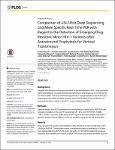Comparison of 454 Ultra-Deep Sequencing and Allele-Specific Real-Time PCR with Regard to the Detection of Emerging Drug-Resistant Minor HIV-1 Variants after Antiretroviral Prophylaxis for Vertical Transmission
Hauser, Andrea
Kücherer, Claudia
Kunz, Andrea
Dabrowski, Piotr Wojtek
Radonić, Aleksandar
Nitsche, Andreas
Theuring, Stefanie
Bannert, Norbert
Sewangi, Julius
Mbezi, Paulina
Dugange, Festo
Harms, Gundel
Meixenberger, Karolin
Background: Pregnant HIV-infected women were screened for the development of HIV-1 drug resistance after implementation of a triple-antiretroviral transmission prophylaxis as recommended by the WHO in 2006. The study offered the opportunity to compare amplicon-based 454 ultra-deep sequencing (UDS) and allele-specific real-time PCR (ASPCR) for the detection of drug-resistant minor variants in the HIV-1 reverse transcriptase (RT). Methods: Plasma samples from 34 Tanzanian women were previously analysed by ASPCR for key resistance mutations in the viral RT selected by AZT, 3TC, and NVP (K70R, K103N, Y181C, M184V, T215Y/F). In this study, the RT region of the same samples was investigated by amplicon-based UDS for resistance mutations using the 454 GS FLX System. Results: Drug-resistant HIV-variants were identified in 69% (20/29) of women by UDS and in 45% (13/29) by ASPCR. The absolute number of resistance mutations identified by UDS was twice that identified by ASPCR (45 vs 24). By UDS 14 of 24 ASPCR-detected resistance mutations were identified at the same position. The overall concordance between UDS and ASPCR was 61.0% (25/41). The proportions of variants quantified by UDS were approximately 2–3 times lower than by ASPCR. Amplicon generation from samples with viral loads below 20,000 copies/ml failed more frequently by UDS compared to ASPCR (limit of detection = 650 copies/ml), resulting in missing or insufficient sequence coverage. Conclusions: Both methods can provide useful information about drug-resistant minor HIV-1 variants. ASPCR has a higher sensitivity than UDS, but is restricted to single resistance mutations. In contrast, UDS is limited by its requirement for high viral loads to achieve sufficient sequence coverage, but the sequence information reveals the complete resistance patterns within the genomic region analysed. Improvements to the UDS limit of detection are in progress, and UDS could then facilitate monitoring of drug-resistant minor variants in the HIV-1 quasispecies.
Dateien zu dieser Publikation
Keine Lizenzangabe
Verwandte Publikationen
Anzeige der Publikationen mit ähnlichem Titel, Autor, Urheber und Thema.
-
2010-11-29ZeitschriftenartikelMinor drug-resistant HIV type-1 variants in breast milk and plasma of HIV type-1-infected Ugandan women after nevirapine single-dose prophylaxis Pilger, Daniel; Hauser, Andrea; Kücherer, Claudia; Mugenyi, Kizito; Kabasinguzi, Rose; Somogyi, Sybille; Harms, Gundel; Kunz, AndreaBackground: Nevirapine single-dose (NVP-SD) reduces mother-to-child transmission of HIV type-1 (HIV-1), but frequently induces resistance mutations in the HIV-1 genome. Little is known about drug-resistant HIV-1 variants ...
-
2014-12-11ZeitschriftenartikelManagement of pregnant women infected with Ebola virus in a treatment centre in Guinea, June 2014 Baggi, F. M.; Taybi, A.; Kurth, Andreas; Herp, M. van; Caro, A. di; Wölfel, Roman; Günther, Stephan; Decroo, T.; Declerck, H.; Jonckheere, S.We report two cases of confirmed Ebola virus disease in pregnant women, who presented at the Médecins Sans Frontières Ebola treatment centre in Guéckédou. Despite the very high risk of death, both pregnant women survived. ...
-
2007-07-18ZeitschriftenartikelPopulation and antenatal-based HIV prevalence estimates in a high contracepting female population in rural South Africa Rice, Brian D; Bätzing-Feigenbaum, Jörg; Hosegood, Victoria; Tanser, Frank; Hill, Caterina; Barnighausen, Till; Herbst, Kobus; Welz, Tanya; Newell, Marie-LouiseBackground: To present and compare population-based and antenatal-care (ANC) sentinel surveillance HIV prevalence estimates among women in a rural South African population where both provision of ANC services and family ...

